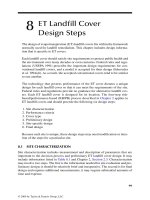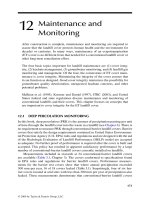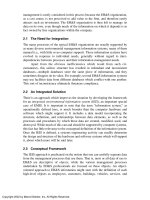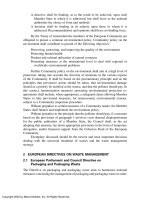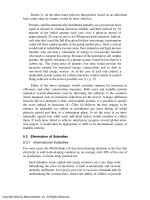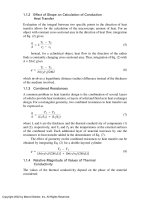Handbook Of Pollution Control And Waste Minimization - Chapter 14 potx
Bạn đang xem bản rút gọn của tài liệu. Xem và tải ngay bản đầy đủ của tài liệu tại đây (414.89 KB, 18 trang )
14
Pollution Prevention and DFE
Terrence J. McManus
Intel Corporation, Chandler, Arizona
1 BASIC PRINCIPLES OF POLLUTION PREVENTION AND
WASTE MINIMIZATION
Beginning in the mid-1970s, environmental management of industrial air emis-
sions and wastewater discharges focused on end-of-the-pipe or end-of-the-stack
treatment technologies. Both the Clean Air Act of 1970 and the Federal Water
Pollution Control Act of 1972 (now called the “Clean Water Act”), as well as the
parallel regulatory structures set up at state and local levels, required new
treatment technologies to be developed to manage air emissions and wastewater
discharges. But none of these early statutes and regulations mandated that
corporations minimize the amount of waste generated or prevent pollution during
manufacturing.
With the passage of the Resource Conservation and Recovery Act (RCRA)
in 1976, the government for the first time defined “hazardous waste” and began
to focus on waste minimization, rather than just waste treatment. Large-quantity
generators [producing more than 1000 kg (2200 lb) per month of hazardous
waste] were required to ship waste to an approved treatment, storage, and disposal
facility (TSDF), using a formal document known as a waste manifest. Because
the new regulations were very strict, however, many off-site TSDFs had to close
down, resulting in a sharp decrease in the supply of such facilities.
Copyright 2002 by Marcel Dekker, Inc. All Rights Reserved.
To reduce demand for the facilities, beyond the sharp rise in costs for TSDF
services, Section 3000(b) of the RCRA requires that large-quantity generators
who transport waste off-site must certify on the manifest that they have estab-
lished a “program in place” to reduce the volume or quantity and toxicity of
hazardous waste generated—to the extent economically practicable. For owners/
operators who manage hazardous waste on-site in a permitted TSDF, Section
3005(h) similarly requires annual certification that a waste minimization program
be in place and maintained in the facility’s operating records. These two require-
ments put the burden of proof on generators or an owner/operators of TSDFs to
show that they are implementing waste minimization strategies.
Small-quantity generators, who produce between 100 and 1000 kg per
month of hazardous waste, are required to certify on their hazardous waste
manifests that they have also “made a good faith effort to minimize” their waste
generators (51 FR 35190; October 1, 1986).
Together, the large- and small-quantity generator requirements for waste
minimization affect more than 95% of the hazardous waste generated in the
United States. The primary mechanism for achieving such minimization is to
identify the various hazardous waste streams and determine if it is possible to
reduce the volume and/or toxicity of each (1).
The U.S. Environmental Protection Agency (EPA) also collects data, annu-
ally, on the emissions and disposal of a specific list of chemical compounds.
Manufacturers who exceed certain thresholds have to inform the EPA as to
whether the chemicals were released into the environment (air, water, or land) or
transferred to another facility for management. The EPA, in turn, maintains a
database known as the Toxics Release Inventory (TRI), which is one of the best
data sources to review emissions performance on an industry sector basis. The
first year for data reporting to EPA’s TRI inventory was 1987. The database tends
to be about two years behind in its reporting, however, as the reports are not due
until July, and loading and analyzing the data takes about a year.
2 ROLE OF POLLUTION PREVENTION AND DESIGN FOR
THE ENVIRONMENT
As methodologies for waste minimization improved in the 1980s, industries
looked to more comprehensive approaches, such as pollution prevention (P2)
and design for the environment (DFE). In 1990, the U.S. Congress passed
the Pollution Prevention Act, which specifically required the evaluation of
new opportunities and approaches to eliminate the generation of emissions
and waste.
Under Section 6602(b) of the Pollution Prevention Act of 1990, Congress
established a policy that:
Copyright 2002 by Marcel Dekker, Inc. All Rights Reserved.
Pollution should be prevented or reduced at the source wherever feasible.
Pollution that cannot be prevented should be recycled in an environmentally
safe manner, wherever feasible.
Disposal and/or release into the environment should be employed only as
a last resort and should be conducted in an environmentally safe manner.
The EPA established an operating definition for P2 as part of the agency’s
1991 Pollution Prevention Strategy. That definition makes clear that prevention
is the first priority within an environmental management hierarchy, which
includes:
1. Prevention
2. Recycling
3. Treatment
4. Disposal or release
The EPA also recognized that any P2 strategy needs to be flexible. Any P2
option today, in fact, depends on three factors: legal requirements, levels of risk
or toxicity reduction that can be achieved, and cost.
As with waste minimization, P2 typically focuses on existing manufactur-
ing processes, by applying the prevention hierarchy to the various waste streams.
When new manufacturing processes are developed, some corporations apply new
environmental management techniques to reduce/eliminate waste generation as
part of their manufacturing process design. This approach has been commonly
called design for the environment (DFE).
Different people have defined DFE in different ways. For instance, the EPA
defines a DFE program as “a voluntary partnership-based program that works
directly with companies to integrate health and environmental consideration in
business decisions (2). Intel Corporation has defined it as “a methodology to
develop environmentally compatible products and processes, while maintaining
desirable product price/performance and quality characteristics.”
3 ENVIRONMENTAL FRAMEWORK
How do all these environmental components or programs work together to form
a unified environmental management system (EMS)? Figure 1 presents a concep-
tual model of the environmental framework. This framework also demonstrates
the evolution of environmental management over time, with waste treatment
beginning at the center, as the earliest management technique, and current and
future management approaches extending from there.
Indeed, waste treatment is the fundamental environmental management
technology applied over many decades. The progression to each succeeding
Copyright 2002 by Marcel Dekker, Inc. All Rights Reserved.
Raw Materials
Process Design
Product Design
WASTE
TREATMENT
WASTE
WASTE
MINIMIZATION
POLLUTION
PREVENTION
DESIGN
FOR THE
ENVIRONMENT
SUSTAINABLE DEVELOPMENT
FIGURE 1 Environmental management evolution.
Copyright 2002 by Marcel Dekker, Inc. All Rights Reserved.
environmental management approach highlights the fact that both the number of
choices and their scope and complexity are continually increasing.
4 SUSTAINABLE DEVELOPMENT
At the current outer edge of the framework is sustainable development. One way
to achieve sustainable development is for many companies and their local
communities to each adopt DFE strategies. In other words, sustainable develop-
ment is the integration of many DFE programs, from many different entities, over
a large geographic area or region. Such a unified approach is necessary because
a single entity cannot provide all the components necessary to prevent pollution
and recycle all recyclable materials. For example, a semiconductor manufacturing
facility can establish programs to collect and recycle aluminum cans, paper
materials, and chemicals. However, the company must rely on the aluminum
industry, the paper recycle industry, and the chemical producers also to implement
recycling in order to use the necessary recycle technology and/or effective and
efficient economies of scale. When a region can develop such an integrated
approach to the environment, the details can be presented in a “green plan.”
In June 1993, President Clinton formed the President’s Council on Sustain-
able Development (PCSD) to develop and recommend a national strategy for
implementing sustainable development. This council consisted of leaders from
industry, government, nonprofit organizations, and Native American groups. In
1996, the PCSD published the report, Sustainable America, which contained the
following vision statement:
Our vision is of a life sustaining earth. We are committed to the
achievement of a dignified, peaceful and equitable existence. A sustain-
able United States will have a growing economy that provides equitable
opportunities for satisfying livelihoods and a safe, healthy, high quality
of life for current and future generations. Our nation will protect its
environment, its natural resource base and the functions and viability of
natural systems upon which all life depends (3, p. IV).
In support of this vision, the Council also recorded 16 beliefs that set the
basis for implementing the strategy. The following four beliefs (3, pp. v–vi) refer
specifically to industrial development:
To achieve our vision of sustainable development, some things must
grow—jobs, productivity, wages, capital and savings, profits, informa-
tion, knowledge, and education—and others—pollution, waste, and pov-
erty must not.
The United States made great progress in protecting the environment in the
last 25 years and must continue to make progress in the next 25 years.
Copyright 2002 by Marcel Dekker, Inc. All Rights Reserved.
We can achieve that goal because market incentives and the power of the
consumers can lead to significant improvements in environmental per-
formance at less cost.
Environmental progress will depend on individual, institutional, and corpo-
rate responsibility, commitment and stewardship.
Steady advances in science and technology are essential to help improve
economic efficiency, protect and restore natural systems, and modify
consumption patterns.
In May 1999, the PCSD published a second progress report, entitled
Towards a Sustainable America. As part of this effort, the council focused
specifically on the following issues (4, p. 3).
1. Policies to reduce greenhouse gas emissions
2. The next steps in building the new environmental management system
for the twenty-first century
3. Policies and approaches to build partnerships to strengthen communi-
ties
4. Policies to foster U.S. leadership in international sustainable develop-
ment policy, particularly in international capital flow
In the area of environmental management, it was very clear to the PCSD
that most recent environmental reforms have not really focused on the objective
of promoting sustainable development. This is partly because current definitions
of environmental pollution, management, and protection are too narrowly scoped,
with significant emphasis on point source emissions. Therefore, the solutions tend
to be focused on single pollutants within a single media from a single source.
Very little effort has been focused on aggregating and understanding environmen-
tal risks and impacts across a broader ecosystem basis. A similar conclusion was
reached by the EPA Science Advisory Board’s (SAB) Integrated Risk Project. In
essence, the SAB believes that environmental management efforts to date have
typically worked on targeted pollutants from single sources, and resulted in
improvements in environmental performance over very localized areas. Specific-
ally, SAB stated that the effort must be more holistic:
Concern for the environment has become an important part of the
American value system. We care about the environment as it relates to
human health, the viability of ecosystems, and our children’s future. We
care about the quality of life, today and in the future, and in the
interconnected environmental conditions that play such an important
role in determining life’s quality (5).
Ultimately, the vision and environmental goals must be to protect the
overall health of all people and the long-term viability of whole ecosystems. That
Copyright 2002 by Marcel Dekker, Inc. All Rights Reserved.
means that risk reduction must be designed to control more than one pollutant at
a time, to protect more than one human or ecological receptor, and thus to realize
broader benefits of environmental improvement, at a lower cost.
The model for such integrated environmental decision making is presented
in Figure 2. The three major components for the decision-making framework are
Problem formulation
Analysis and decisionmaking
Implementation and performance evaluation
Each of these steps requires constant feedback of information to both improve
and optimize the specific measures implemented, yet some of the advantages of
using an integrated decision-making model include:
An increase in the probability of focusing on the highest risks/most impor-
tant issues
A methodology that includes both human health and ecological risks
PROBLEM FORMULATION
Risk Comparison Goal Setting
Preliminary Options Analysis
Deliberations
ANALYSIS & DECISION-MAKING
Risk Assessment Screening/Selection
Options Analysis Deliberation
Performance Measures
IMPLEMENTATION and
PERFORMANCE EVALUATION
Implementation Monitoring
Reporting and Evaluation
Information
Expert Judgement
Public Values
Legal and
Institutional Milieu
Report Card
Has Problem
Changed?
Report Card
Meeting Objectives?
Source:
Integrated Environmental Decision-making
in the 21st Century - EPA/SAB
FIGURE 2 Integrated environmental decision-making framework.
Copyright 2002 by Marcel Dekker, Inc. All Rights Reserved.
Improvements in public accountability (because the framework is applied
typically over a larger geographic area)
The inclusion of specific performance measurements
One of the biggest stumbling blocks to integrated environmental decision
making is the fact that this approach is a marked departure from the current
methodology for environmental management. That means it takes more time, in
the beginning, to communicate with and educate the public so that they are
willing to participate.
5 COMMON FOCUS AREAS AND DRIVERS FOR P2
AND DFE
Most industrial operations are committed to improvements in environmental
performance and natural resource protection. The broad categories that industries
focus on and try to manage are
Solid and hazardous waste generation
Chemical use
Air emissions
Water use
Wastewater discharge quantity and quality
Electrical use
Each category includes specific manufacturing operations that use natural re-
sources or produce emissions and that therefore need the corporation’s attention.
Some of the reasons that corporations manage these processes in environmentally
efficient ways are that they:
Reduce operating costs
Ensure compliance with environmental permits
Satisfy certification requirements of RCRA on waste manifests
Achieve a specific threshold, which eliminates reporting requirements or
allows the corporation to achieve minor source status under an air
emissions permit
Satisfy corporate commitments established in an environmental policy or a
specific commitment to a local community
Ensure that emissions reporting under TRI demonstrates reduction from
previous year’s emission reporting data
Help the corporation develop a reputation as a “good corporate citizen”
The following example for waste solvent generation illustrates this ap-
proach for an individual manufacturing facility. The basic methodology for
implementing either pollution prevention or design for the environment includes:
Copyright 2002 by Marcel Dekker, Inc. All Rights Reserved.
1. Identify which areas/manufacturing operations generate emissions and/
or consume natural resources (waste solvent generation is selected for
this example).
2. Within the specific operation under evaluation, identify the various
sources of waste solvent that are generated and identify the quantities
per unit of time, quantities per unit of production, and characteristics
of the waste solvent source(s).
3. Develop a list of options to recycle, reduce the volume, eliminate, or
reduce the toxicity of the waste solvent that is generated.
4. Evaluate each potential option, using the following criteria as a minimum:
Capital cost to implement
Operating costs per year
Quantities of waste solvent reduced or eliminated
Reduction in toxicity
Environmental impacts of the remaining materials/waste
Health and safety advantages and disadvantages for implementing the
proposed option
5. Select the best option for each solvent waste stream and implement.
6. Track performance of the implemented option and compare the data
with original projections.
7. Reassess the option implemented and determine whether further im-
provements can be implemented, using the same basic methodology
again.
6 INDUSTRY SECTOR APPROACH TO P2 AND DFE
Inevitably, each industrial manufacturing operation must determine how it will
specifically implement its environmental management system and determine the
proper leverage point for applying pollution prevention or design for the environ-
ment strategies. Within a specific industrial manufacturing sector, however,
similarities in the manufacturing processes and chemistries frequently result in
similarities in types of waste or emissions generated. Evaluations of P2 and/or
DFE opportunities could be realized more efficiently by establishing specific
design criteria or environmental performance goals at a sector level, rather than
on a company or individual manufacturing facility basis. Both the semiconductor
and metal finishing industries have embarked upon sector-wide approaches.
6.1 Semiconductor Manufacturing
More than three decades ago, Gordon Moore of Intel Corporation predicted that
the number of transistors in a defined area of silicon would double every 18
months. This prediction, known as Moore’s law, is presented in Figure 3. To keep
Copyright 2002 by Marcel Dekker, Inc. All Rights Reserved.
pace with the increasing demand for higher performance and more electronic
features, the semiconductor manufacturing process must continue to shrink the
feature size on a chip. As the chip shrinks, the distance between transistors
decreases, which in turn increases the speed of the device. Figure 4 presents a
graphical picture of the rate of change of the semiconductor manufacturing process.
Essentially, a new manufacturing process comes on line every two years. Currently,
most of the manufacturing technology in the semiconductor industry is operating at
a feature size of 0.25 µm and moving to 0.18 µm and on to 0.13 µm in 2002.
The rapid rate of change in manufacturing provides many opportunities for
applying DFE strategies. Each new manufacturing tool set that is developed can
be reviewed, and specific sources of air/water emissions or waste generation can
be targeted for continuous improvement in the next generation.
To assist in DFE approaches, semiconductor companies leverage the trade
association known as the Semiconductor Equipment and Materials International
(SEMI) to establish environmental, health, and safety (EHS) design guidelines for
new manufacturing equipment. The two primary guidelines are SEMI S2, “Safety
Guidelines for Semiconductor Manufacturing Equipment,” and SEMI S8, “Safety
Guidelines for Ergonomic Engineering of Semiconductor Manufacturing Equip-
ment.” These two documents provide the basis for establishing design for EHS.
Table 1 summarizes the environmental requirements contained in the SEMI S2
document.
’70 ’73 ’76 ’79 ’82 ’85 ’88 ’91 ’94 '97 2000
Transistors
Per Die
10
8
10
7
10
6
10
5
10
4
10
3
10
2
10
1
10
0
1K
4K
16K
64K
256K
1M
16M
4M
64M
4004
8080
8086
80286
i386™
i486™
Pentium
®
Memory
Microprocessor
Source: Intel
Pentium
®
II
Pentium
®
III
256M
Pentium
®
Pro
FIGURE 3 Moore’s law.
Copyright 2002 by Marcel Dekker, Inc. All Rights Reserved.
Since these are industry-wide EHS guidelines for developing new manu-
facturing tools, individual semiconductor manufacturers do not have to develop
their own unique set of requirements. Nor do they suffer from the imposition of
environmental design guidelines. It should be noted that this approach does not
prevent individual semiconductor manufacturers from imposing additional stand-
ards that are stricter than those set forth in SEMI S2 or S8, on specific tools.
Implementation of the SEMI S2 guidelines by equipment manufacturers
increased in acceptance globally in the early to mid-1990s. Through the im-
plementation of the S2 guidelines and other approaches taken by the semiconduc-
tor industry, significant success in reducing emissions has been achieved. An
example of this improvement is demonstrated in Table 2 and Figure 5, which
presents the release of hazardous air pollutants (HAPs) by the U.S. semiconductor
industry.
Using the TRI database, HAPs emissions data were generated for the
semiconductor industry. For the period 1987–1990 (four years), the average
annual HAPs emissions by the U.S. semiconductor industry was 4.09 million
pounds. For the period 1994–1997, average annual HAPs emissions were 0.83
million pounds, which represents a fivefold decrease in HAPs emissions.
Figure 5 presents the HAPs emission data in pounds per million square
inches of silicon wafers produced by U.S. semiconductor manufacturers. Table 2
0%
10%
20%
30%
40%
50%
60%
70%
80%
90%
100%
Q198
Q298
Q398
Q498
Q199
Q299
Q399
Q499
Q100
Q200
Q300
Q400
0.35um 0.25um 0.18 um
Source: Intel
TWO YEARS
Forecast Data
CPU Units
Shipped (%)
FIGURE 4 Semiconductor technology conversion (0.35 to 0.18 µm).
Copyright 2002 by Marcel Dekker, Inc. All Rights Reserved.
provides the absolute quantity of HAPs emissions; Figure 5 reflects the fact that
production quantities of semiconductor wafers have increased each year since
1987. Both the absolute quantity of HAPs emissions and the quantity per unit of
production have continued to decrease.
Table 3 presents the total quantity of TRI chemical releases or transfers for
both the U.S. semiconductor industry and all U.S. industry. The data demonstrate
that the semiconductor industry produces less than 1% of the total TRI and that,
based on 1997 data, that sector has reduced TRI releases and transfers by a factor
of 3.5, compared to the first reporting year of 1987. During that same period, U.S.
industry as a whole reduced TRI releases by a factor of 2.7.
In summary, with the rapid change of manufacturing technology that
occurs within semiconductor manufacturing, the opportunities for engaging in
design for the environment are substantial. Use of SEMI S2 environmental
guidelines provides clear design guidelines for equipment suppliers on the types
of environmental improvements desired by the semiconductor industry. The key
to implementation is early engagement in the manufacturing development pro-
TABLE 1 Summary of Semiconductor Manufacturing Equipment
International (SEMI) Environmental Design Considerations
The Environmental Design Guidelines apply across the full life of the equip-
ment, including decommissioning and disposal. The equipment manufac-
turer should consider resource conservation, including:
Water reuse/recycling
Reduce consumption of chemicals, energy, and water
Reduce resource requirements for equipment maintenance and reduc-
tion in packaging requirements
The use of chemicals for processing, maintenance, and utilities must con-
sider chemical use effectiveness, environmental impacts, toxicity, waste
generation, and decommissioning.
Where practicable, the following chemicals should not be part of use or
operation:
Ozone-depleting substances as specified by the Montreal Protocol
Perfluorocarbons, including CF4, C2F6, NF3, C3F6, SF6, and CHF3
The equipment design must also reduce potential for unintended releases,
and include such features as overfill detectors and alarms, secondary
containment, chemical compatibility, and automatic shutoff of chemical
feed systems.
Segregation of effluents, wastes, and emissions needs to be provided to
prevent issues with chemical incompatibility, facilitation of recycle and
reuse, and to facilitate effective treatment technologies.
Equipment must also be designed to facilitate decommissioning.
Copyright 2002 by Marcel Dekker, Inc. All Rights Reserved.
cess. Figure 6 presents a model for early engagement to achieve DFE within
semiconductor manufacturing.
6.2 Metal Finishing
The metal finishing industry is characterized typically as a small manufac-
turing operation with about 10,000 job-shop or captive facilities across the
United States. Under the Clean Water Act, the EPA defines metal finishing as
follows:
Plants which perform any of the following six metal finishing operations
on any basis material: Electroplating, Electroless Plating, Anodizing,
Coating (chromating, phosphating and coloring), Chemical Etching and
Milling and Printed Circuit Board Manufacture. If any of those six
operations are present, then this part applies to discharges from those
operations and also to discharges from any of the following 40 process
operations: Cleaning, Machining, Grinding, Polishing, Tumbling, Bur-
nishing, Impact Deformation, Pressure Deformation, Shearing, Heat
Treating, Thermal Cutting, Welding, Brazing, Soldering, lame Spraying,
Sand Blasting, Other Abrasive Jet Machining, Electric Discharge Ma-
chining, Electrochemical Machining, Electron Beam Machining, Laser
Beam Machining, Plasma Arc Machining, Ultrasonic Machining, Sinter-
ing, Laminating, Hot Dip Coating, Sputtering, Vapor Plating, Thermal
TABLE 2 Hazardous Air Pollutants
(HAPs) Emissions by U.S. Semiconductor
Industry (1987–1997)
Year HAPs emissions (million pounds)
1987 3.85
1988 4.76
1989 4.30
1990 3.43
1991 2.82
1992 2.21
1993 1.39
1994 1.12
1995 0.88
1996 0.77
1997 0.55
Source: EPA Toxins Release Inventory (TRI) Data-
base (1987–1997).
Copyright 2002 by Marcel Dekker, Inc. All Rights Reserved.
Infusion, Salt Bath Descaling, Solvent Degreasing, Paint Stripping,
Painting, Electrostatic Painting, Electropainting, Vacuum Metalizing,
Assembly, Calibration, Testing and Mechanical Plating (6).
The primary pollutants generated by metal finishing are wastewaters con-
taining heavy metals, waste solvent, and heavy metal-containing debris. The
manufacturing technology changes less rapidly than that in the semiconductor
industry, but is, in fact, more representative of the majority of U.S. manufacturing
sectors. Typically, changes in metal finishing manufacturing are upgrades of
specific tools within an existing line. One of the biggest improvements, which
began about two decades ago, was the use of countercurrent rinsing techniques
to reduce the volumes and heavy metal concentrations of wastewater generated
during metal plating.
One of the concerns for this industry is that the heavy metals contained in
the wastewater frequently discharge to a publicly owned treatment works
(POTW) and accumulate in the municipal treatment plant’s sludge or pass through
the facility and discharge with the treated effluent. Therefore, significant effort
has been undertaken under the Clean Water Act to reduce the emissions of metals
from this industry sector.
SOURCE: EPA TRI Database (1987-97); Dataquest (June 1999)
1987 1988 1989 1990 1991 1992 1993 1994 1995 1996 1997
0
1
2
3
4
FIGURE 5 HAPs release by U.S. semiconductor manufactures as a function of
silicon substrate production (1987–1997).
Copyright 2002 by Marcel Dekker, Inc. All Rights Reserved.
In 1993, EPA Administrator Carole Browner embarked on a new program,
known as the Common Sense Initiative (CSI), to determine if a more effective
approach to environmental regulations and management could be achieved through
an industry sector-by-sector approach. The metal finishing industry was one of
six selected for the CSI, with the goal to promote “cleaner, cheaper, smarter”
environmental performance. One major outcome was a commitment by the metal
finishing industry to reduce its environmental footprint. Table 4 presents the
environmental commitments of the metal finishing industry developed under CSI.
The environmental goals set forth on both a facility and sector-wide basis
in Table 4 provide the necessary direction for using quantitative performance
goals to achieve design for the environment within the metal finishing industry.
If successful, this industry will significantly reduce its emissions of metals into
the environment and achieve significant reductions in consumption of natural
resources, with specific emphasis on reducing water and energy use. Through the
reductions in water and energy use, the industry should also reduce its operating
costs and make it more competitive. Since this was a cooperative effort between
the industry and the EPA, the agency has also agreed to reduce by 50% the
administrative burden. This, in turn, reduces the operating costs of these types of
metal finishing facilities.
In summary, P2 and DFE represent opportunities for industrial facilities to
improve their environmental performance and, in many instances, reduce operat-
TABLE 3 Total Quantity of TRI Chemical
Releases or Transfers for U.S. Semiconductor
Manufacturing and All U.S. Industry (1987–1997)
Year
U.S. semiconductor
(million pounds)
All U.S. industry
(million pounds)
1987 70.4 7,011.2
1988 38.7 6,489.0
1989 32.5 5,705.7
1990 24.5 4,999.2
1991 28.7 4,411.4
1992 26.0 4,299.2
1993 20.9 3,754.6
1994 15.3 3,134.9
1995 22.3 2,637.6
1996 18.1 2,545.3
1997 18.7 2,586.9
Source: EPA Toxics Release Inventory (TRI) Database,
1987–1997.
Copyright 2002 by Marcel Dekker, Inc. All Rights Reserved.
YEARS to High Volume Manufacturing
Ability to Effect Change
642 0
Manufacturing RampSupplier R&DExternal Research
Process Development
Commercialization Phases Demonstration Ramp to HVM
Very early
engagement
through
universities
and
government
labs
Early
engage-
ment
through
tool
supplier
targets
Optimum Time
to effect change
in technology
Technology
frozen, major
changes
require much
more effort -
use
continuous
improvement
Research
FIGURE 6 EHS technology engagement model for semiconductor manufacturing.
Copyright 2002 by Marcel Dekker, Inc. All Rights Reserved.
(1) Improved Resource Utilization
(“Smarter”)
(a) 98% of metals ultimately utilized
on product.
(b) 50% reduction in water pur-
chased/used (from 1992 levels).
(c) 25% reduction in facility-wide
energy use (from 1992 levels).
(2) Reduction in Hazardous Emissions
and Exposures (“Cleaner”)
(a) 90% reduction in organic TRI
emissions and 50% reduction in
metals emissions to air and
water (from 1992 levels).
(b) 50% reduction in land disposal
of hazardous sludges and a re-
duction in sludge generation
(from 1992 levels).
(c) Reduction in human exposure to
toxic materials in the facility and
the surrounding community,
clearly demonstrated by actions
selected and taken by the facil-
ity. Such actions may include,
for example, pollution preven-
tion, use of state-of-the-art emis-
sion controls and protective
equipment, use of best recog-
nized industrial hygiene prac-
tices, worker training in
environmental hazards, and par-
ticipation in a Local Emergency
Planning Committtee.
(3) Increased Economic Payback and
Decreased Costs (“Cheaper”)
(a) Long term economic benefit to
facilities achieving Goals 1 and 2.
(b) 50% reduction in costs of unnec-
essary permitting, reporting,
monitoring and related activities
(from 1992 levels), to be im-
plemented through burden re-
duction programs to the extent
that such efforts do not ad-
versely impact environmental
outcomes.
(4) Industry-Wide Achievement of Facil-
ity Goals.
(a) 80% of facilities nationwide
achieve Goals 1–3.
(5) Industry-Wide Compliance with
Environmental Performance
Requirements.
(a) All operating facilities achieve
compliance with Federal, State
and Local environmental perfor-
mance requirements.
(b) All metal finishers wishing to
cease operations have access to
a government sponsored “exit
strategy” for environmentally
responsible site transition.
(c) All enforcement activities involv-
ing metal finishing facilities are
conducted in a consistent man-
ner to achieve a level playing
field, with a primary focus on
those facilities that knowingly
disregard environmental
requirements.
Note: At facilities where outstanding
performance levels were reached prior
to 1992, the percentage-reduction tar-
gets for Goals 1(b) and (c) and 2(a) and
(b) may not be fully achievable, or the
effort to achieve them may not be the
best use of available resources. In these
instances, a target should be adjusted
as necessary to make it both meaning-
ful and achievable.
Source: Ref. 8.
TABLE 4 Metal Finishing National Performance Goals: A Vision for a
Cleaner, Cheaper, Smarter Future
Facility-based performance goals
(by 2002)
Sector-wide performance goals
(by 2002)
Copyright 2002 by Marcel Dekker, Inc. All Rights Reserved.
ing costs. Several industry sectors, such as metal finishing and semiconductor
manufacturing, have moved to an industry sector-wide approach to help facilitate
the implementation of P2 and DFE. It is anticipated that sector-wide approaches
will provide additional encouragement for individual facilities to move forward
in implementing new environmental management techniques.
REFERENCES
1. “Waste Minimization Requirements,” />F68B964A59054380852565DA006F08E1.
2. “Design for the Environment,” .
3. President’s Council on Sustainable Development, Sustainable America: A New Con-
sensus for Prosperity, Opportunity and a Healthy Environment for the Future. Wash-
ington, DC: U.S. Government Printing Office, 1996.
4. President’s Council on Sustainable Development, Towards a Sustainable America—
Advancing Prosperity, Opportunity and Health Environment for the 21st Century.
Washington, DC: U.S. Government Printing Office, May 1999.
5. U.S. Environmental Protection Agency, Science Advisory Board, Integrated Environ-
mental Decision Making in the 21st Century. Draft Document, May 3, 1999, p. 1.
6. Code of Federal Regulations, 1998 Version, 40 CFR Section 433.10.
7. Safety Guidelines for Semiconductor Manufacturing Equipment, Semiconductor
Equipment and Materials International (SEMI) S2, 2000 Version, pp. 23–24.
8. EPA Common Sense Initiative, Metal Finishing Sector, “Strategic Goals Program—
National Performance Goals and Action Plan,” www.strategicgoals.org/plan/part1.htm.
Copyright 2002 by Marcel Dekker, Inc. All Rights Reserved.

